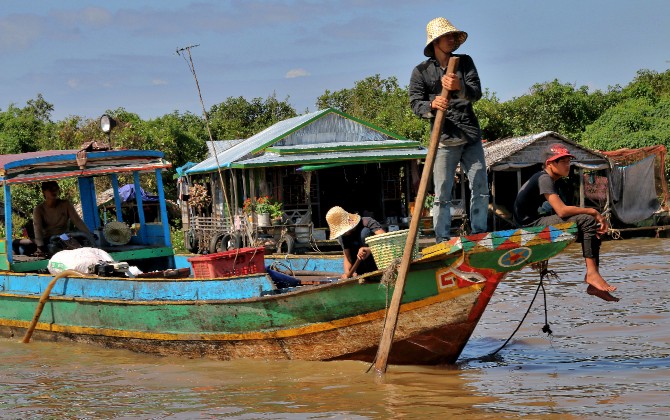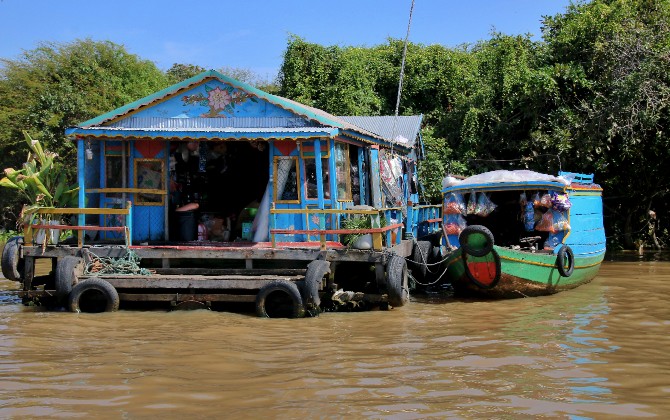SIEM REAP RIVER, Cambodia |
||
 |
||
Going-home traffic at dusk of bicycles, tuk-tuks, cars, and pedestrians as the river sees it. |
||
————————————————————————————————— This essay was originally posted to National Geographic's Water Currents blog on March 16, 2015. —————————————————————————————————
As I flow through the town of Siem Reap, Cambodia, I am slow moving and bucolic-looking most of the year, with green parks and benches for people to sit and watch me flow by. But sometimes during rainy season I overflow and flood nearby buildings and roads. Along both sides of my banks there are old collapsing wooden houses hanging precariously over the water. These are currently being torn down in order to clean my body, while the local inhabitants will be relocated to rice fields nearby.
I have been sick for a long time, with plastic bottles and bags clogging my flow, but now there is an effort to dredge my underbelly by removing trash. I can definitely breathe better as they make progress. |
||
 |
||
Dwelling collapsing into Siem Reap River. Photo by Derek Irland |
||
My source is a spring on the most holy mountain in Cambodia, Mt. Kulen (which means lichee fruit), and I have a long, dramatic history to tell. Almost one thousand years ago I helped to build the grand architectural sacred complex of Ankor Wat, when thousands of bamboo rafts floated along my body for thirty miles carrying over three million heavy stones from a sandstone quarry to be used in the construction of the temples. Today, I still have the grand opportunity everyday to see segments of the splendid World Heritage Site structures as I flow south toward Tonlé Sap Lake.
From my beginning I chug along downhill for fifty miles where I reach Tonlé Sap, Khmer for “Vast Body of Fresh Water,” which fills and shrinks in cycles. As a combined lake and river system we provide much needed water for Cambodia’s rice fields. Our shores are dotted with floating villages bobbing up and down while people onboard are busy going about their daily chores. |
||
 |
||
The floating villages of Tonle Sap Lake. Photo by Derek Irland |
||
 |
||
The floating villages of Tonle Sap Lake. Blue houses usually denote the home of a Vietnamese family. Photo by Derek Irland |
||
I may appear to be a quiet and innocent stream, but I have witnessed a brutal, sad history. The name Siem Reap translates as the “Defeat of Siam” (about 1516–1566), today’s Thailand, which refers to the old conflict between the Khmer and Siamese nations.
In more recent times of the past forty years I unfortunately saw many of the residents living along my shores killed and maimed in senseless savage events. From 1965 until 1973 US troops flew over Cambodia with B-52 bombers loaded with napalm and cluster-bombs with the intent to destroy Viet Cong supply lines and hideouts. These planes dropped more bombs here than were dropped on Japan during World War II, killing anywhere from 150,000 to 500,00 Cambodians.
But there was more horror on the horizon. From 1975-1979 a vicious regime called the Khmer Rouge, under the leadership of Pol Pot, evacuated towns whose residents were forced out to rural, agricultural communes to work in labor camps. Families were separated, Buddhist monks were killed, temples destroyed.
There was to be no music, no intimacy, no wearing glasses (which meant, heaven forbid, that you were an intellectual), no laughing, no crying. All of these “crimes” were punishable by death. Estimates vary, but between 2-3 million people, about a quarter of the country’s population were killed during this time from murder, starvation, and disease. |
||
 |
||
Ankor Wat World Heritage Site. Photo by Derek Irland |
||
One of the few places that was not entirely destroyed, although it was heavily ransacked, was Ankor Wat. A friend of mine who grew up along my banks is Khieu Seavathdy. Her grandfather, father and extended family hid out along with six thousand other refuges within the walls of the temple for two years from 1970-1972. It was not until April 1998 that Pol Pot died and not until 2014 that two of the Khmer Rouge leaders were finally brought to trial and sentenced to life in prison. Khieu tells me that even today there are television programs to try and reunite families that were separated four decades ago.
This legacy of so much war has left behind another major problem of land mines. Most of the ones around my banks have been cleared away, but there are still hundreds of unexploded land mines and bombs throughout our country. Cambodia has about 40,000 amputees, among the highest in the world, so everyday there are land-mine victims begging as they rest under a tree by my shore.
We are currently in a phase of stability, with a vigorous tourist industry and it is hoped by everyone here that finally a time of peace and recovery can begin. |
||
next page: Chao Phraya River >
< previous page: Kamo River




































